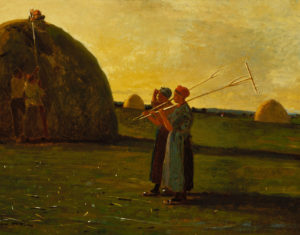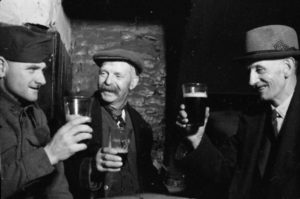One of the best things about summer, if you ask me, is that it comes with an automatic soundtrack––it does in my head, at least. It has its beginnings with Kate Bush dancing through my head and singing “The Sensual World” on Bloomsday, June 14, and soon progresses to Felix Mendelssohn’s music for Shakespeare’s A Midsummer Night’s Dream on St. John’s Eve and St. John’s Day (June 23 & 24). On the Fourth of July the song by the same name by X pops into my head, along with John Philip Sousa and the bit of Tchaikovsky’s 1812 Overture that includes the cannon. And then any number of old Shaker spirituals come to me on the Sixth of August as we celebrate the Arrival of the Shakers in America.
And now, on August 11, Sirius, the Dog Star, ends its annual period of rising and setting with the sun. This heliacal rising and setting has been going on since the Third of July. The Ancient Greeks, watchers of the sky and namers of the constellations, observed this and deduced that Sirius, shining as brightly as it does, was amplifying and contributing to the heat of the sun, making these days the hottest of the year. We know now that Sirius has nothing to do with that heat, but legends have long legs, don’t they?
What does this have to do with summer soundtracks, then? Well, in London in the summer of 1998, a woman named Florence Welch rode her bicycle each day past an enormous illuminated sculpture installed at London’s South Bank. The sculpture, an arc of giant illuminated perspex and aluminum letters, was by Swiss artist Ugo Rondinone. It’s message: Dog Days are Over.
Florence Welch would go on to form a band called Florence + the Machine, and eventually they would record a song called, you guessed it: Dog Days are Over. You probably know it. The song was inspired by the sculpture. Florence is quoted as saying, “It’s a reference to the dog star, Sirius. When it was closest to the Earth, all the animals would get languid and sleepy. When it moved away, they’d wake up.” She may not have the details quite right, but she’s got the gist of the matter… and I rather like the vision of sentient beings being languid and sleepy for 40 days or so each summer, then suddenly awakening.
All to say that this is how Dog Days are Over by Florence + the Machine fits into the soundtrack of summer that lives in my head. I share it with you each year around this time… and now you know why. I picture happiness hitting me like a train on a track and I picture those very blue women beside me as I sing the song each summer. One of those blue women reminds me of our cat Haden’s veterinarian… and then I picture Dr. Irma Morales as a back up singer for Florence Welch, clapping her hands: one-two/three.
What can I say? My mind drifts and wanders. It has always done this, since I was a boy. But this same mind fills my summers with music––even beyond the constant and deafening mid-August buzzing of Florida cicada song––and that’s not so bad, is it?
Please save an upcoming date with me!
August 24 brings a great celebration with an odd name: it’s the Bartlemas Wayzgoose, and I’ll be hosting the online, virtual Library Wayzgoose Festival for the Jaffe Center for Book Arts at Florida Atlantic University Libraries. It’s a video event full of good stories and great music. The Bartlemas Wayzgoose is an old printers’ celebration that comes about every 24th of August with the waning summer. My featured guest is activist letterpress printer Ben Blount of Evanston, Illinois, with a special Wayzgoose Concert by the wonderful Jay Ungar & Molly Mason, the Grammy Award winning musicians famous for their song “Ashokan Farewell” from the Ken Buns documentary The Civil War. Perhaps we can add that to the soundtrack of summer, too. Lots of great Wayzgoose fun is in store for you. The video premiere will be at www.jaffecollection.org and at the Jaffe Center’s Vimeo Channel, too, and at the Facebook pages of Convivio Bookworks and the Jaffe Center for Book Arts (essentially, we’re making it really hard for you to miss). The premiere is on Bartlemas night, Tuesday August 24th, at 7 PM Eastern Daylight Time, with video available anytime after that, from wherever you are in the world. I think you’ll really love it. I’ll be posting more about it as Bartlemas approaches, so watch the blog and our social media pages at Instagram and Facebook (@conviviobookworks).
Summer Sale!
At our online shop, our Summer High Five Sale continues: All summer long, use discount code HIGH5 at checkout for $5 off your purchase of $35 on everything in the shop. Take it to $50 and earn free domestic shipping, too. Click here to shop! Our favorite new thing in the shop? Millie’s Tea Towels, embroidered by hand by my mom Millie, under our new Linens & Textiles category.
Image: Dog Days are Over by Ugo Rondinone. Perspex, neon, translucent film, and aluminum, 1998. For context as to what Florence Welch saw each day as she bicycled past, Rondinone’s illuminated sculpture is about 25 feet wide x 11 feet tall.


